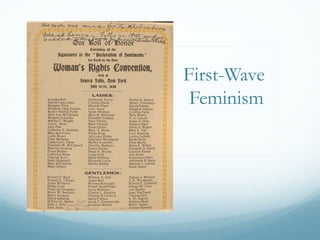
First wave feminism
- 2. Waves vs. Waterfalls This section will cover the first of three major “waves” of feminism. The word “wave” is used to categorize feminism because it illustrates the forward motion—and then resistance or loss of motion—of the women’s movement(s). It helps to understand this movement in by thinking of the motion of an actual wave (in, toward the sand, then back out). As each wave of feminism pushed forward with progress and change, the result was often a “backward” motion (or a standstill) so to speak. In women’s studies, this is called a backlash.
- 3. The First Wave: An Overview The efforts of women in the 19th century that led to the passage of women’s right to vote in 1920 is often referred to as the First Wave of feminism. First Wavers were primarily concerned with women’s political equality, specifically the right to vote.
- 4. First-Wave Feminism: Getting Started 1840s – 1850s: reform movements that coalesced with the Seneca Falls Convention in 1848 Led by Elizabeth Cady Stanton, Lucretia Mott, and others Main focus was the right to vote Led primarily by white women who supported restrictions to the right to vote based on race and property ownership Left: Lucretia Mott (1793-1880) Right: Elizabeth Cady Stanton (1815-1902)
- 5. The Declaration of Sentiments: How Did It Work? • Relied on 15 “facts” that proved “the history of mankind is a history of repeated injuries and usurpations on the part of man toward woman, having in direct object the establishment of an absolute tyranny over her” (562) • Passed 12 resolutions arguing that “woman is man’s equal” and that men should encourage women to speak, teach, participate in religious assemblies. The latter strategy is important because it recognized the need for both men AND women to participate in the “zealous and untiring efforts” toward equal rights.
- 6. The Seneca Falls Convention (1848) The Declaration of Sentiments The Declaration of Sentiments was based on the Declaration of Independence; it placed the onus on women to take action to protect themselves for the future.
- 7. First-Wave Feminism: Founding Beliefs The right to vote is a necessary tool for all other aspects of emancipation This focus had advantages and disadvantages: Advantages •Concrete reform •Mobilizing effect •Symbolized participation of women—as individuals —in public life. Disadvantages •Required approval of male voters/politicians. •Forced to adopt any argument necessary (often invoked traditional gender roles) •Intensified racism, nativism, and class bias
- 8. First-Wave Feminism: Confronting other Oppressions • Multiplicity of Oppressions: the process by which multiple forms of oppression—race, gender, class—are connected. • Because of this multiplicity of oppression, sexism is “indissolubly linked” to other forms of oppression, abuse, and inequality (Kesselman 557). Anna Julia Cooper, African-American feminist activist, (1858-1964)
- 9. First-Wave Feminism: African-American Voices Sojourner Truth (1797- 1883) former slave religious speaker; anti-slavery activist; feminist • Delivered a famous speech, “Ain’t I a Woman?” at the Women’s Convention in Akron, Ohio, in 1851 (the link will take you to a video of actress Alfre Woodard performing Sojourner Truth’s speech; here is the text of the speech) •Effective rhetorical appeal based on religion (i.e. women’s roles in birthing and caring for Jesus) •Instrumental in developing consciousness raising (sharing of personal experience) as a political tool •Demonstrates the emotional and intellectual force behind women’s rights movement, even for women who had little or no formal education
- 10. First-Wave Feminism: The Cult of the “New Woman” and The Vote “New Woman”: early 20th c. image of woman as self- reliant and engaged with the world. In 1920, the 19th Amendment is passed, granting women the right to vote
- 11. Defining Feminism The term “feminism” is introduced in the U.S. (approx. 1910) Feminism: distinguishes suffragists from those who argued for the “full integration of women into” all aspects of “social, political, and economic life” (Kesselman 557) “We want simply to be ourselves…not just our little female selves but our whole big human selves” –Marie Jenny Howe, 1914
- 12. First-Wave Feminism: After the Vote Legal and accessible birth control Expansion of educational opportunities Crusade against lynching and other race-based violence and injustice Fight for improved working conditions Goals of the women’s movement became more diverse, with leaders organizing smaller groups focused on other issues affecting women:
- 13. First-Wave Feminism: Backlash and Indifference 1930s The women’s movement loses numbers and influence Many women are indifferent to their newfound right to vote Women who do vote, work outside the home, and/or participate publicly in political movement are harshly criticized The Great Depression results in legislation restricting the employment of married women (Ruth 499)
- 14. First-Wave Feminism: The Legacy 1940s World War II prompts patriotic movement that relies on women’s work in factories to support war efforts. Two major consequences are: A lasting shift in attitudes about women’s aptitudes and proper roles Married women workers demonstrated work-family balance
- 15. First-Wave Feminism: The Legacy, cont’d. 1950s With war over and men needing to return to their jobs (and thus their “proper” gender roles), the focus returns to the nuclear family, which requires women back in the home. These images were advertisements designed to encourage women to buy household items that could then be used to signify what good mothers and wives they were, as evidenced by their clean houses and shiny new appliances. Redirecting women’s attention to what they could buy was supposed to make the idea of returning to the domestic sphere a more appealing idea.
